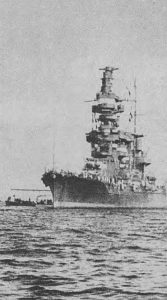IN THE THIRTY YEARS since 1945, the Indian Navy has developed from a force of sloops, minesweeper and trawlers to an independent oceangoing Navy, operating its own carrier task force, ...
Article topics
Captain A.S. Rosenthal DSO and Bar, OBE, RAN
The Catapult Fighters
For two years during World War II, from 1941 to 1943, the Catapult Aircraft Merchant Ships, assisted by Fighter Catapult Ships of the Royal Navy, played an important role in ...
Battle Cruisers in Collision
Australians at Zeebrugge
HMAS Perth Loses her Walrus
Battle Honours for HMA Ships and Fleet Air Arm Squadrons
Japanese Destroyers In Battle of Sunda Strait
The Battle of Sunda Strait was won by Japanese destroyers. In no other action in the Pacific War were their destroyers given the opportunity of using the tactics they had ...
The Argentine Navy 1849-1974
HIRMS Rynda Arrives
Christmas in the RAN 1944
Christmas 1944 was celebrated in a variety of ways and under widely differing conditions in the RAN. Here are just a few recorded by C. Hermion Gill. THERE WERE, HOWEVER, ...
Commissioned for 69 Days-HMAS Boonaroo
Admiral Sir Lionel Halsey, GCMG, GCVO, KCIE, CB, DLJP 1872-1949
New South Wales Naval Forces
This article appeared in The Navy and Army Illustrated dated 15th October 1897. The New South Wales Naval Brigade was the least developed of the Colonial Navies for the obvious ...
Merchant Ship Losses in Australian Waters in WW2
Forty four Allied merchant vessels were lost by enemy action in Australian waters in World War II. With a total tonnage of 196073 the ships ranged from the 12568 ton ...
HMAS Bendigo – New Guinea 1942
White Lady of the North – HMAS Moresby
At the end of World War II most of the older small ships of the RAN, which had served valiantly in peace and war, were disposed of. At this time ...
Pacific Chase
Honorary Commodore – Captain A. V. Knight
This biography of Australia’s most distinguished Reserve Officer is told by his former First Lieutenant. Captain A. V. Knight, OBE, DSC, RD, US Legion of Merit RANR(S) Rtd, served with ...
A Century of Japanese Intelligence – Part IV
Origins of the QUEENSLAND Navy
Old Thunder and Lightning – the Origins of the Queensland Navy IT WAS A RUSSIAN SCARE in the eighteen seventies that caused the Queensland Government of the day to form ...
Ship Design at the Turn of the Century
The turn of the century produced an unusual range of warships as these photographs show: ...
Sydney’s Walrus in battle with three Italian fighters
IN RESPONSE TO THE ARTICLE ‘Pusser’s Bus’ which appeared in the December issue, Vice-Admiral Sir John Collins, Sydney’s Captain in the Mediterranean, writes: ‘I feel sure that Sydney’s Walrus should ...
Surrender of Yokosuka Naval Base
A Century of Japanese Intelligence – Part III
In the third instalment of his article on Japanese Intelligence Lt.Cdr. Swan describes in detail the vast network of spies planted in California, Mexico and Hawaii by the Japanese. An ...








